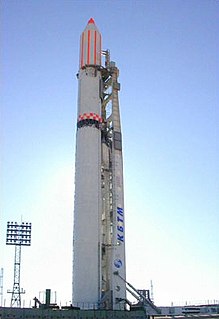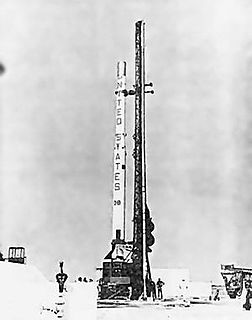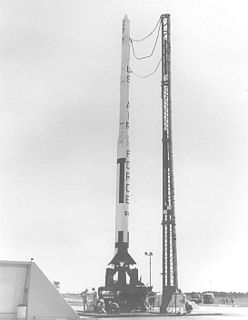Related Research Articles

1971 saw the last three known deaths of cosmonauts of the Soviet space program and the only deaths in space. Their mission was to man humanity's first space station. The experimental bay door failed to separate so the first crew failed to dock and second crew were killed on re-entry. 1971 also saw the launch of the first and only British satellite on top of a British rocket after that success the program was cancelled.

Strela is a Russian orbital carrier rocket, derived from the Soviet/Russian UR-100NU missile. It conducted its maiden test launch on 5 December 2003, carried its first functional payload on 27 June 2013, and a second one on 19 December 2014.

Site 45 at the Baikonur Cosmodrome is a launch site used by Zenit rockets. It consists of two pads, one of which is still in use. It has been the launch site for all Soviet and Russian government Zenit launches, along with a commercial launch conducted for Globalstar in 1998, and continuing commercial launches under the Land Launch programme. The main pad at the site is area 45/1, which was completed in 1983 following five years of construction. A second pad, area 45/2, was completed in 1990, but was destroyed by a launch failure in the same year.

The R-7A Semyorka, GRAU index 8K74, was an early Soviet intercontinental ballistic missile derived from the earlier R-7 Semyorka. It was the only member of the R-7 family of rockets to be deployed as an operational missile. The R-7A first flew on 23 December 1959, entered service on 31 December of the same year, and was formally accepted on 20 January 1960. It was declared fully operational on 12 September 1960 and was retired from service in 1968.

Site 32 at the Plesetsk Cosmodrome is a launch complex formerly used by Tsyklon-3 carrier rockets. It consists of a two launch pads, Site 32/1 and Site 32/2, which were used between 1977 and 2009. It has the GRAU index 11P868. Site 32 is, along with Site 35 and Site 41 one of three sites under consideration for the Angara programme.
Site 41, also known as Lesobaza and SK-1, was a launch complex at the Plesetsk Cosmodrome in Russia. It consisted of a single pad, Site 41/1, and was used by R-7 derived rockets between 1959 and 1989.
Kosmos 320, also known as DS-MO No.3 was a technology demonstration satellite which was launched by the Soviet Union in 1970 as part of the Dnepropetrovsk Sputnik programme. Its primary mission was to demonstrate orientation control by means of an aerodynamic skirt stabiliser. It also carried an optical research payload for the Soviet Armed Forces.
Kosmos 327, also known as DS-P1-I No.8 was a satellite which was used as a radar target for anti-ballistic missile tests. It was launched by the Soviet Union in 1970 as part of the Dnepropetrovsk Sputnik programme.
Kosmos 497, also known as DS-P1-I No.12 was a satellite which was used as a radar target for anti-ballistic missile tests. It was launched by the Soviet Union in 1972 as part of the Dnepropetrovsk Sputnik programme.
Kosmos 919, also known as DS-P1-I No.19 was a satellite which was used as a radar target for anti-ballistic missile tests. It was launched by the Soviet Union in 1977 as part of the Dnepropetrovsk Sputnik programme.

The NOTS-EV-2 Caleb, also known as NOTS-500, Hi-Hoe and SIP was an expendable launch system, which was later used as a sounding rocket and prototype anti-satellite weapon. It was developed by the United States Navy's Naval Ordnance Test Station (NOTS) as a follow-up to the NOTS-EV-1 Pilot, which had been abandoned following ten launches officially classified as failed missions. Two were launched in July and October 1960, before the cancellation of the project. Following cancellation, two leftover Calebs were used in the Satellite Interceptor Program (SIP), while three more were used as sounding rockets, under the designation Hi-Hoe. These derivatives flew until July 1962, when the Hi-Hoe made its final flight.

Scout X-1 was an American expendable launch system and sounding rocket which was flown seven times between August 1960 and October 1961. Four orbital and three suborbital launches were made, with four of the launches resulting in failures.

The RM-90 Blue Scout II was an American sounding rocket and expendable launch system which was flown three times during 1961. It was used for two HETS test flights, and the launch of the Mercury-Scout 1 satellite for NASA. It was a member of the Scout family of rockets.

The RM-89 Blue Scout I was an American sounding rocket which was flown four times between January 1961 and April 1962. It was used for Two HETS test flights, and a flight to investigate atmospheric re-entry. It was a member of the Scout family of rockets.

Launch Area 3 (LA-3) at the Wallops Flight Facility is a launch complex which was used, mostly by Scout rockets, between 1960 and 1985. Forty-one Scout launches occurred from the complex, making both orbital and suborbital. In addition, four Nike sounding rockets were launched from the complex in 1970.
Scout X-2M was an American expendable launch system which was flown three times between May 1962 and April 1963. It was a four-stage rocket, based on the earlier Scout X-2, but with an MG-18 upper stage instead of the Altair used on the X-2. It was a member of the Scout family of rockets.
The Scout X-2B was an American expendable launch system which was flown during 1963. It was a four-stage rocket, based on the earlier Scout X-2, but with an Altair 2A fourth stage in place of the Altair 1A used on the X-2. It was a member of the Scout family of rockets.

Launch Area 4 (LA-4), also known as the South Launch Site or SLS, and LC-43, is the only active Long March launch complex at the Jiuquan Satellite Launch Center. It consists of two launch pads; SLS-1 / 921 (LC-43/91) and SLS-2 / 603 (LC-43/94). SLS-1 has been the launch site for all missions conducted as part of the Shenzhou programme, including the first Chinese crewed spaceflight, Shenzhou 5. Since it was activated in 1999; Long March 2C, Long March 2D, Long March 2F, Long March 4C and Long March 11 rockets have launched from LA-4.
Launch Complex 1, also known as Pad 1, is a Long March launch complex at the Taiyuan Satellite Launch Centre. It consists of a single launch pad, which has been used by Long March 2C, Long March 4A, Long March 4B and Long March 4C carrier rockets. Until the activation of Launch Complex 2 in 2008, it was the only launch site for Long March 4 rockets. Long March 4 launches have since also occurred from Jiuquan.
Istrebitel Sputnikov, or IS, was a Soviet anti-satellite weapons programme which led to the deployment of the IS-A or I2P system during the 1970s and 1980s. IS satellites were originally intended to launch on UR-200 rockets, but following the cancellation of the UR-200, the Polyot, Tsyklon-2A and Tsyklon-2 rockets were used instead.
References
- 1 2 McDowell, Jonathan. "UR-200". Orbital and Suborbital Launch Database. Retrieved 2 March 2012.
- 1 2 3 McDowell, Jonathan. "R-36". Orbital and Suborbital Launch Database. Retrieved 2 March 2012.
- ↑ Wade, Mark. "UR-200". Encyclopedia Astronautica. Retrieved 2 March 2012.
- ↑ Wade, Mark. "Tsiklon-2A". Encyclopedia Astronautica. Retrieved 2 March 2012.